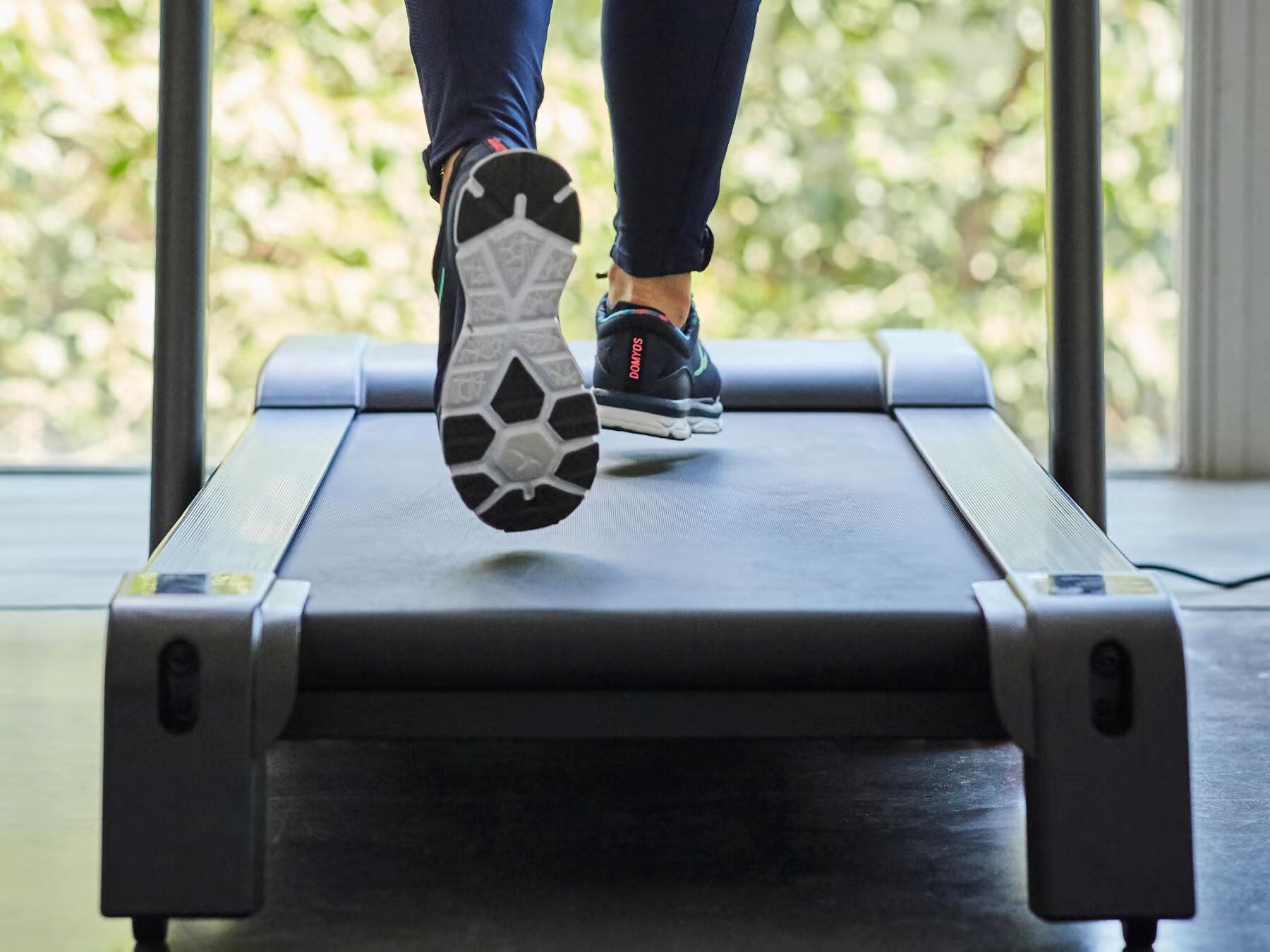

Featured
Why Do Speed Work For Distance Running?
Modified: October 24, 2023
Improve your distance running with speed work. Learn why incorporating speed work into your training can help you become a faster and stronger runner. Featured tips and techniques.
Introduction
When it comes to distance running, most runners typically prioritize building their aerobic endurance through long, steady-paced runs. While this is a crucial aspect of training, incorporating speed work into your routine can bring about numerous benefits and take your running performance to the next level.
Speed work refers to training sessions that involve running at a faster pace than your usual steady-paced runs. This can include interval training, tempo runs, fartlek training, and hill repeats, among others. These workouts are designed to challenge your aerobic and anaerobic systems, improve running economy, increase aerobic capacity, enhance performance in races, and even reduce the risk of injury.
In this article, we will delve into the various benefits of speed work in distance running, explore different types of speed work, highlight guidelines for incorporating speed work into your training program, and provide insights on how to listen to your body throughout the process.
Whether you are a beginner looking to improve your running abilities or a seasoned runner aiming for a personal best, speed work should be an essential component of your training regimen. So, lace up your running shoes, tighten your laces, and let’s dive into the world of speed work in distance running!
Benefits of Speed Work in Distance Running
Speed work offers a wide array of benefits for distance runners. Let’s explore some of the key advantages:
- Improved Running Economy: Speed work sessions force your body to adapt to a faster pace, which can lead to improved running economy. This means you become more efficient in utilizing oxygen and energy, translating into better overall running performance.
- Increased Aerobic Capacity: Speed work challenges your aerobic system by pushing you to run at a higher intensity. This stimulates your body to adapt by increasing the delivery and utilization of oxygen, ultimately enhancing your aerobic capacity. As a result, you’ll be able to sustain faster paces for longer periods of time.
- Enhanced Performance in Races: Regular speed work trains your body to handle faster paces, making your race pace feel more manageable. As your fitness and speed improve, you’ll be able to achieve better race times and reach your performance goals.
- Injury Prevention: Speed work involves varying your running intensity, which can help prevent overuse injuries. By incorporating different types of speed work and giving your body sufficient rest and recovery, you can strengthen muscles, improve flexibility, and reduce the risk of injury.
These benefits highlight the importance of including speed work in your training routine. By embracing the challenge of running at faster paces, you can unlock your full potential as a distance runner and take your performance to new heights.
Improved Running Economy
Running economy refers to the efficiency with which your body uses oxygen while running. It is a critical factor in distance running performance, as better running economy allows you to maintain faster paces for longer durations. Incorporating speed work into your training routine is an effective way to improve your running economy.
During speed work sessions, your body is forced to adapt to a faster pace than your usual steady run. This adaptation process involves a variety of physiological changes that enhance your running economy. One of the key adaptations is an improved neuromuscular coordination, as your body learns to recruit and synchronize muscle fibers more effectively. This leads to a more efficient muscle contraction and reduces energy wastage.
Additionally, speed work helps improve your running form and technique. When running at a faster pace, your body naturally tries to optimize its movement to cope with the increased demands. Over time, this leads to refined running mechanics, where unnecessary movements are minimized and energy is conserved.
Another aspect of improved running economy through speed work is the increased utilization of stored energy sources. Running at a higher intensity taps into glycogen stores more rapidly, training your body to become more efficient at utilizing these energy sources. This adaptation can further improve your endurance and allow you to sustain faster paces for longer durations.
Ultimately, the combination of improved neuromuscular coordination, refined running mechanics, and enhanced utilization of energy sources leads to a more efficient running economy. The result is a greater ability to sustain faster paces, delay fatigue, and ultimately perform better in races.
So, whether you’re aiming to achieve a new personal best or simply become a more efficient runner, incorporating speed work into your training routine is crucial for improving your running economy.
Increased Aerobic Capacity
Aerobic capacity, also known as VO2 max, is a measure of your body’s ability to utilize oxygen during exercise. It plays a crucial role in distance running performance, as a higher aerobic capacity allows you to sustain faster paces for longer periods of time. Incorporating speed work into your training routine is an effective way to increase your aerobic capacity and enhance your running performance.
Speed work sessions challenge your aerobic system by pushing you to run at a higher intensity. This intensity demands more oxygen consumption, which stimulates your body to adapt and improve its ability to deliver and utilize oxygen more efficiently. Over time, this adaptation leads to an increase in your aerobic capacity.
One of the key adaptations that occur with speed work is an increase in the number of capillaries surrounding your muscles. Capillaries are tiny blood vessels responsible for delivering oxygen-rich blood to the working muscles. The more capillaries there are, the greater the oxygen supply to the muscles. Speed work also promotes the development of more mitochondria within your muscle cells. Mitochondria are the powerhouses of the cells and play a vital role in aerobic energy generation. Having more mitochondria increases your muscles’ ability to produce energy aerobically, improving your endurance capabilities.
Speed work also leads to an increase in aerobic enzyme activity. Enzymes are catalysts that facilitate various biochemical reactions, including those involved in aerobic energy production. By increasing the activity of these enzymes, your body becomes more efficient at utilizing oxygen to generate energy.
In addition to these physiological adaptations, speed work sessions also help improve your mental toughness and ability to handle discomfort. When you push yourself during speed work, you learn to embrace discomfort and train your mind to stay focused and motivated during challenging moments in races.
By incorporating speed work into your training routine, you can increase your aerobic capacity and improve your ability to sustain faster paces for longer durations. This translates into better overall performance and a greater confidence in your running abilities.
Enhanced Performance in Races
For distance runners, race day is the culmination of weeks or months of training and preparation. Incorporating speed work into your training routine can significantly enhance your performance in races and help you achieve your goals.
Regular speed work trains your body to handle faster paces, making your race pace feel more manageable. By challenging yourself to run at a higher intensity during speed work sessions, you condition your body to adapt and become more efficient at sustaining faster paces over longer distances.
One of the key benefits of speed work is improved mental resilience. During speed work, you push yourself outside your comfort zone, confronting physical and mental barriers. This experience builds mental toughness and prepares you to face the challenges that arise during races. By becoming accustomed to the discomfort and fatigue associated with faster paces, you develop the mental strength to push through when the going gets tough on race day.
Speed work also helps you develop a stronger finishing kick. By incorporating intervals or fast finishes into your workouts, you train your body to maintain a strong pace even when fatigued. This can give you a competitive edge in the final stages of a race, allowing you to overtake other runners and finish strong.
In addition to the physical and mental benefits, speed work can improve your race strategy and pacing. By practicing running at a variety of paces, you become more familiar with your different speeds and learn to gauge your effort more accurately. This can help you establish a more effective race plan and prevent starting too fast or fading towards the end.
Ultimately, by incorporating speed work into your training routine, you prepare yourself physically and mentally for the demands of race day. You develop the necessary speed, endurance, and mental resilience to perform at your best and achieve your race goals.
Injury Prevention
As a distance runner, staying injury-free is crucial for maintaining consistent training and achieving your running goals. Incorporating speed work into your training routine can actually help reduce the risk of running-related injuries.
One of the main reasons speed work reduces the risk of injury is that it helps strengthen your muscles and connective tissues. When you run at faster paces, your muscles are subjected to higher forces and stress. Over time, this stress promotes the development of stronger muscles, tendons, and ligaments, making them more resistant to injury.
Additionally, speed work often involves a variety of running surfaces and terrains. For example, hill repeats and trail running can introduce variety to your training, which helps prevent repetitive stress injuries. By running on different surfaces, you engage different muscles and reduce the risk of overuse injuries that may occur when running on the same surface for extended periods.
Speed work also helps to identify and correct any muscle imbalances or weaknesses. When pushing the pace, your body requires optimal alignment and balance. If there are any imbalances or weaknesses, they become more apparent during speed work. By identifying these weaknesses, you can incorporate targeted strength training and corrective exercises to address them, reducing the risk of injury.
Furthermore, speed work sessions typically include warm-up and cool-down routines. These routines help to prepare your muscles and joints for the training session and aid in the recovery process afterward. Proper warm-up and cool-down routines improve blood flow to the muscles, increase joint mobility, and reduce the likelihood of strains or sprains.
It’s important to note that while speed work can reduce the risk of injury, it should be approached with caution and gradually incorporated into your training routine. It’s crucial to listen to your body and avoid overtraining or pushing too hard, as this can increase the risk of injury. Remember to include rest days and recovery periods in your training schedule.
By incorporating speed work into your training routine and taking proper precautions, you can strengthen your muscles, address imbalances, and reduce the risk of running-related injuries. This will enable you to maintain consistent training and ultimately reach your running goals.
Types of Speed Work
Speed work encompasses various training techniques that challenge your body to run at a faster pace than your usual steady runs. These different types of speed work can add variety to your training routine and help you achieve specific goals. Let’s explore some common types of speed work:
- Interval Training: Interval training involves alternating between periods of fast running and recovery. This work-rest pattern can be structured in various ways, such as running a specific distance or time at a fast pace, followed by a rest or easy recovery jog. Interval training improves your anaerobic capacity and trains your body to sustain faster paces for longer durations.
- Tempo Runs: Tempo runs are sustained efforts at a comfortably hard pace, often at or slightly below your lactate threshold. These runs challenge your aerobic system and improve your ability to sustain a faster pace over longer distances. Tempo runs are typically longer in duration compared to interval training.
- Fartlek Training: Fartlek, which means “speed play” in Swedish, is a type of unstructured speed work that involves alternating between periods of fast and easy running. This can be done by picking landmarks or random cues during your run and increasing your speed for a predetermined duration or distance. Fartlek training adds spontaneity and fun to your workouts while improving your speed and overall running fitness.
- Hill Repeats: Hill repeats involve running up a hill at a challenging effort level, followed by an easy recovery jog or walk back down the hill. This type of speed work builds strength, power, and improves your ability to handle hilly terrain. Hill repeats can be incorporated on both inclines and declines to simulate different race courses.
These are just a few examples of the different types of speed work you can incorporate into your training routine. It’s important to choose the type that aligns with your training goals and current fitness level. Experimenting with different types of speed work can add variety and excitement to your training, keeping you motivated and continually challenging your body.
Interval Training
Interval training is a popular form of speed work that involves alternating between periods of fast running and recovery. It is an effective training technique for improving anaerobic capacity, increasing speed, and enhancing endurance. Interval training can be structured in various ways, depending on your goals and fitness level.
One common form of interval training is the classic “repeats” workout. In this workout, you run a specific distance or time at a fast, intense pace, followed by a period of recovery. For example, you might run 400 meters at a near-maximum effort, followed by a 200-meter easy jog or walk to recover. This work-rest pattern is repeated multiple times, with the aim of maintaining a high intensity during the fast intervals while allowing for adequate recovery between repetitions.
Another form of interval training is the “pyramid” workout. This workout involves gradually increasing and then decreasing the distance or time of the fast intervals. For instance, you might start with a 200-meter sprint, then move to 400 meters, 800 meters, and so on, before gradually decreasing the distance back down. The recovery period between intervals remains consistent or may increase slightly as the intervals become longer.
Interval training can also involve “threshold” intervals, which are run at a pace that is slightly below your lactate threshold. This is the point where your body produces lactate at a faster rate than it can clear it. By running just below this threshold, you challenge your body’s ability to clear lactate and improve your lactate threshold pace over time.
Furthermore, interval training can be tailored to specific race distances or goals. For example, if you’re training for a 10K race, you might incorporate longer intervals, such as 800 meters or 1,000 meters, at a fast pace. On the other hand, if you’re training for a shorter distance like a 5K, you might focus on shorter and faster intervals, such as 200 meters or 400 meters.
When incorporating interval training into your routine, it’s important to maintain proper form and technique. Focus on running with good posture, engaging your core, and maintaining a quick turnover. Gradually increase the intensity and volume of your intervals over time, as your body adapts to the workload.
Interval training provides a multitude of benefits for distance runners, including improved anaerobic capacity, increased speed, enhanced endurance, and mental resilience. With proper planning and progressive overload, interval training can help you reach new levels of performance and achieve your running goals.
Tempo Runs
Tempo runs are a beneficial form of speed work that allow you to improve your threshold and build endurance. These runs are sustained efforts at a comfortably hard pace, typically at or slightly below your lactate threshold. Tempo runs are an integral part of distance running training and can help you develop the ability to sustain faster paces over longer distances.
Running at a tempo pace pushes your aerobic system and challenges your body to maintain a faster pace. By training at or slightly below your lactate threshold, you can improve your body’s capacity to clear lactate and sustain a hard effort for a prolonged period.
Tempo runs typically last for 20 to 60 minutes, depending on your fitness level and training goals. It’s important to find a pace that feels comfortably hard but sustainable for the duration of the run. This pace should be challenging enough to elicit adaptations in your aerobic system but not so demanding that you cannot maintain it for the entire tempo run.
One benefit of tempo runs is that they improve your running efficiency and economy. As you train at your threshold pace, you develop a better sense of pace and running mechanics. Your body learns to maintain a strong and efficient form, which can carry over to your race performance.
Tempo runs also provide mental benefits. Sustaining a challenging pace for an extended period requires mental focus and fortitude. Tempo runs help develop mental resilience, enhancing your ability to push through fatigue and discomfort during races.
It’s important to incorporate tempo runs strategically into your training. Depending on your training plan and race goals, you may include one or two tempo runs per week. However, be mindful of not overdoing them, as they place significant stress on your body. Recovery between tempo runs and other workouts is crucial for avoiding overtraining and reducing the risk of injury.
To maximize the benefits of tempo runs, incorporate a proper warm-up and cool-down. Begin with an easy jog and include dynamic stretches to prime your muscles for the harder effort. After the tempo run, gradually bring your heart rate down with a gentle jog and perform static stretches or foam rolling to aid in recovery.
By including tempo runs in your training routine, you can improve your lactate threshold, enhance endurance, and develop the mental toughness necessary to sustain a challenging pace in your races. Incorporate tempo runs wisely, progress gradually, and enjoy the rewards of improved running performance.
Fartlek Training
Fartlek training, which means “speed play” in Swedish, is a versatile and unstructured form of speed work that adds spontaneity and fun to your running routine. Fartlek sessions involve alternating between periods of faster running and easy recovery. This type of training allows you to challenge yourself and improve your speed and endurance while enjoying the freedom of running at your own pace.
During a fartlek run, you can incorporate speed bursts of varying distances and intensities. For example, you might choose a landmark such as a tree, lamppost, or street sign, and sprint to it at a near-maximum effort. After the sprint, you can recover by running at an easy pace until you feel ready to pick another landmark and repeat the process.
The beauty of fartlek training is that you have the flexibility to adjust the intensity and duration of each speed burst based on how you feel in the moment. This makes fartlek training suitable for runners of all fitness levels and provides the opportunity to tailor the workout to your specific needs and goals.
Fartlek training offers several benefits. Firstly, it helps you develop your aerobic and anaerobic fitness by challenging both energy systems during the varied intensity intervals. Secondly, fartlek training allows you to improve your speed, as the bursts of faster running help you develop a higher turnover rate and increase your running efficiency. Additionally, fartlek sessions help you sharpen your mental focus and improve your ability to embrace discomfort, which can be valuable during races.
Aside from the physical and mental benefits, fartlek training adds excitement and variety to your runs. It breaks up the monotony of steady-state running and allows you to explore different routes and terrains. The freedom to choose when and where to increase your pace keeps the workout engaging and enjoyable.
When incorporating fartlek training into your routine, it’s important to listen to your body and adjust the intensity and duration of each speed burst based on your fitness level and training goals. Remember to include a proper warm-up and cool-down to prepare your body for the workout and aid in recovery.
Whether you’re a beginner looking to introduce speed work into your training or an experienced runner seeking a change of pace, fartlek training offers a versatile and effective method to improve your speed, endurance, and overall running performance. So, lace up your running shoes, head out for a run, and let the speed play begin!
Hill Repeats
Hill repeats are a challenging yet rewarding form of speed work that can significantly improve your strength, power, and endurance as a distance runner. This training technique involves running up a hill at a hard effort, followed by an easy recovery jog or walk back down the hill.
Hill repeats offer numerous benefits to runners. One of the key advantages is increased lower body strength. Running uphill requires your muscles to work harder against gravity, particularly targeting your glutes, quadriceps, hamstrings, and calf muscles. As you incorporate hill repeats into your training routine, these muscles become stronger and more resilient, which can improve your overall running performance.
In addition to building strength, hill repeats are an effective way to improve running efficiency and stride power. The incline of the hill forces you to increase your power output, and as a result, you naturally engage more muscle fibers and recruit more muscle groups. This enhanced recruitment of muscle fibers can lead to improved running form, a more powerful stride, and increased stride length, all of which can contribute to faster race times on flat surfaces.
Hill repeats also provide an opportunity to develop mental toughness and resilience. Running uphill requires mental fortitude, as it can be physically demanding and mentally challenging. Through consistent hill repeat training, you build mental resilience, learn to embrace discomfort, and develop the mental strength necessary to push through challenging moments during races.
When incorporating hill repeats into your training routine, it’s important to choose a hill with a challenging but manageable grade. The length of the hill should be suitable for your fitness level, allowing you to maintain good form and sustain an effort that feels hard but sustainable for the designated number of repeats. As you progress, you can increase the number of repetitions or the distance covered in each repeat.
Ensure you have a proper warm-up before starting hill repeats to prepare your muscles for the effort and reduce the risk of injury. Begin with an easy jog and incorporate dynamic stretches and exercises that target the muscles involved in hill running. After completing the repeats, remember to include a cool-down period with an easy jog and static stretches to aid in recovery.
By incorporating hill repeats into your training routine, you can improve your strength, power, running efficiency, and mental resilience. Embrace the challenge of running uphill and enjoy the rewards it brings to your overall running performance.
Guidelines for Incorporating Speed Work in Training
When incorporating speed work into your training routine, it’s important to follow certain guidelines to ensure that you reap the maximum benefits while minimizing the risk of injury. Here are some key guidelines to consider:
1. Frequency and Duration: Start by incorporating one or two speed work sessions per week into your training routine. As you progress and your body adapts, you can gradually increase the frequency to three times per week. The duration of each speed work session can vary depending on the type of workout, but aim for 20-60 minutes, including warm-up and cool-down.
2. Progressive Overload: Start with shorter intervals or tempo runs and gradually increase the intensity and volume over time. This allows your body to adapt and avoids overtraining. Keep track of your progress and gradually challenge yourself with longer intervals, faster paces, or increased repetitions.
3. Warm-Up and Cool-Down: Before starting any speed work session, warm up your muscles and joints with an easy jog and dynamic stretches. This increases blood flow, primes your muscles, and reduces the risk of injury. After the workout, cool down with an easy jog and include static stretches to aid in recovery.
4. Listening to Your Body: Pay attention to how your body feels during speed work. It’s normal to experience fatigue and discomfort, but be mindful of signs of excessive fatigue or pain. If you feel overly fatigued or experience persistent pain, it may be a sign of overtraining or an impending injury. Adjust the intensity or take an extra rest day if needed. It’s essential to strike a balance between pushing yourself and avoiding pushing too hard.
5. Variety and Progression: Incorporate a variety of speed work sessions into your training routine, such as intervals, tempo runs, fartlek runs, and hill repeats. This variety helps target different energy systems and keeps your training engaging. Additionally, progress gradually by increasing the intensity, distance, or repetitions over time to continue challenging your body and stimulating progress.
6. Recovery and Rest: Allow for adequate rest and recovery between speed work sessions. Your body needs time to repair and adapt to the stresses of high-intensity training. Include easy or rest days in your schedule and prioritize sleep, nutrition, and self-care to support recovery and optimize performance.
By following these guidelines, you can safely and effectively incorporate speed work into your training routine. Speed work will help you improve your running performance, increase your speed and endurance, and ultimately move closer to achieving your running goals.
Frequency and Duration
When incorporating speed work into your training routine, it’s essential to carefully consider the frequency and duration of your sessions. Balancing the right amount of speed work with proper recovery is key to maximizing performance and reducing the risk of overtraining and injury.
Frequency: As a general guideline, it’s recommended to start with one or two speed work sessions per week. This allows your body to adapt to the demands of high-intensity training. As you progress and your fitness improves, you can gradually increase the frequency of speed work sessions to three times per week. However, keep in mind that individual differences and training goals may influence the optimal frequency, so it’s important to listen to your body and adjust accordingly.
Duration: The duration of a speed work session can vary depending on the type of workout and your current fitness level. Including warm-up and cool-down, aim for a total duration of 20-60 minutes. As a beginner, start with shorter intervals or tempo runs and gradually increase the duration and intensity over time as your body adapts to the training stimulus.
It’s important to strike a balance between pushing your limits and avoiding excessive fatigue. Proper recovery between speed work sessions is crucial to allow for adaptation and minimize the risk of injury. Additionally, consider your overall training plan and schedule to ensure there is enough time for rest and recovery between intense workouts.
Remember that speed work sessions place higher demands on your body than steady-paced runs. They involve challenging your anaerobic system and pushing your limits. As a result, it’s important to approach speed work with caution and gradually increase the intensity and duration as your fitness level improves.
Keep in mind that individual factors such as age, training history, and current fitness level can influence the optimal frequency and duration of speed work sessions. It’s recommended to work with a coach or seek guidance from an experienced runner or trainer who can provide personalized advice based on your specific needs and goals.
By finding the right balance of frequency and duration for your speed work sessions, you can optimize your training and improve your speed, endurance, and overall running performance. So, lace up your shoes, hit the track or trails, and incorporate speed work strategically into your training routine.
Progressive Overload
Progressive overload is a fundamental principle of training that applies to all forms of exercise, including speed work. It involves gradually increasing the demands placed on your body to continually stimulate adaptation and improvement in your running performance. When incorporating speed work into your training routine, applying the principle of progressive overload is crucial for long-term success.
Start at an Appropriate Level: Begin with a level of intensity and volume that challenges you but is sustainable. Avoid the temptation to start at a level that is too intense, as this can lead to overtraining and potential injuries. By starting at an appropriate level, you establish a solid foundation and allow your body to adapt more effectively.
Gradually Increase the Intensity: As your body adapts to the initial demands of speed work, it’s important to progressively increase the intensity of your workouts. This can be done by running at faster paces, reducing recovery time between intervals, or increasing the grade or length of hill repeats. The key is to push yourself slightly outside your comfort zone, but still maintain proper form and technique.
Extend the Duration: Alongside increasing the intensity, gradually extend the duration of your speed work sessions. For example, you can progress from shorter intervals to longer intervals or build up the time spent at threshold pace during tempo runs. This progression challenges your aerobic and anaerobic systems, allowing them to adapt and improve over time.
Increase Volume or Frequency: Another way to apply progressive overload is by increasing the total volume of speed work in your training routine. This can be achieved by adding extra repetitions, extending the number of intervals, or increasing the frequency of speed work sessions. However, be cautious not to increase volume or frequency too rapidly, as this can lead to overtraining and increased risk of injury.
Individualize the Progression: It’s important to note that the principles of progressive overload can vary from person to person. Factors such as age, fitness level, training history, and recovery capacity should be considered when determining the appropriate progression. It’s recommended to monitor your own response to training and adjust the progression accordingly to ensure a suitable balance between challenge and recovery.
Periodize Your Training: To optimize the benefits of progressive overload, it’s beneficial to incorporate periodization into your training. Periodization involves organizing your training into specific phases, with each phase targeting different aspects of fitness and performance. This allows for systematic progression, adequate recovery, and optimal adaptation.
By consistently applying the principle of progressive overload in your speed work, you can continually challenge your body, stimulate adaptation, and improve your running performance. It’s important to remember that progression should be gradual and individualized, always keeping your long-term goals and overall training plan in mind.
Warm-Up and Cool-Down
The warm-up and cool-down are essential components of any speed work session. They provide numerous benefits, including injury prevention, improved performance, and enhanced recovery. Incorporating a proper warm-up and cool-down routine into your training can make a significant difference in your overall running experience.
Warm-Up: The purpose of the warm-up is to prepare your body for the upcoming speed work session. It gradually increases your heart rate, activates your muscles, improves blood flow, and enhances flexibility. A well-executed warm-up can help prevent injuries, improve performance, and mentally prepare you for the training ahead.
A standard warm-up routine for speed work may include:
- Easy Jog: Start with an easy jog for 5-10 minutes. This increases your body temperature and gradually raises your heart rate.
- Dynamic Stretches: Incorporate dynamic stretches that focus on the major muscle groups involved in running. This can include leg swings, walking lunges, high knees, and leg kicks. Dynamic stretching helps improve flexibility, increases range of motion, and activates the muscles needed for speed work.
- Strides: Include a few strides or accelerations of about 50-100 meters at an increased pace. Strides help further activate your muscles and prepare your body for the faster effort.
Cool-Down: The cool-down is just as important as the warm-up and should not be neglected. It aids in gradually bringing down your heart rate, removes metabolic waste products, reduces the risk of muscle soreness, and promotes efficient recovery.
A recommended cool-down routine for speed work may include:
- Easy Jog: After completing the speed work session, allow for an easy 5-10 minutes of jogging at a relaxed pace. This helps to gradually lower your heart rate and promote active recovery.
- Static Stretches: Incorporate static stretches focusing on the major muscle groups used in the workout. Hold each stretch for 15-30 seconds, focusing on relaxing and elongating the muscles.
- Self-Massage or Foam Rolling: Consider using a foam roller or performing self-massage on targeted muscle groups to enhance recovery and relieve any areas of tightness or tension.
By including a proper warm-up and cool-down routine in your speed work sessions, you can optimize your performance, reduce the risk of injury, and enhance your overall running experience. Allocate time for these important components of training to ensure that your body is adequately prepared and properly recovers from the demands of speed work.
Listening to Your Body
Listening to your body is a crucial aspect of incorporating speed work into your training routine. While speed work can be highly beneficial, it’s essential to pay attention to the signals your body is sending and adjust your training accordingly. Here are some key considerations for listening to your body during speed work:
Recognize Fatigue vs. Discomfort: It’s normal to experience fatigue and discomfort during speed work. Pushing your limits can be challenging both physically and mentally. However, it’s crucial to differentiate between normal fatigue and excessive fatigue or pain. If you feel overly tired or experience persistent pain, it may be a sign of overtraining or an impending injury. In such cases, it’s important to dial back the intensity, take an extra rest day, or seek professional advice.
Adjust the Intensity: Your body’s response to training can vary day to day. Factors such as sleep, nutrition, stress, and overall well-being can significantly impact your performance. If you’re feeling particularly tired or run down, it’s important to listen to your body and adjust the intensity of your speed work session. This may mean running at a slightly slower pace or reducing the number of repetitions. Remember, it’s better to have a solid, quality workout at a slightly lower intensity than to push yourself through a subpar performance.
Monitor Recovery: Recovery is a crucial component of training, especially when incorporating speed work. Alongside your regular rest days, it’s important to pay attention to how well you’re recovering between workouts. If you find that you’re consistently fatigued or sore, it may be a sign that your body needs additional recovery time. Consider adding extra rest days or reducing the intensity or volume of your speed work sessions until you feel adequately recovered.
Be Mindful of Niggles and Pains: As a runner, it’s common to experience niggles or minor pains from time to time. Pay attention to any discomfort that arises during or after your speed work sessions. If you notice pain that is persistent, worsening, or in a specific area, it’s important to address it promptly. Rest, ice, compression, and elevation (RICE) can help in the initial stages, but if the pain persists, it’s advisable to seek professional advice to prevent the potential development of an injury.
Embrace Flexibility: Flexibility in training is a key element of listening to your body. While it’s important to have a structured training plan, it’s equally important to allow for flexibility and adjustments based on how you’re feeling. Don’t be afraid to modify your speed work session or swap it with an easier run or cross-training session if you feel it’s necessary. Remember, it’s better to prioritize your long-term well-being and enjoyment of running than to push yourself to the point of burnout or injury.
Listening to your body is an ongoing process that requires attention and self-awareness. By tuning into the signals your body sends and making necessary adjustments to your training, you can find the right balance that allows for progress, enjoyment, and optimal performance in your speed work sessions.
Conclusion
Incorporating speed work into your distance running training can bring about a myriad of benefits. From improved running economy and increased aerobic capacity to enhanced performance in races and injury prevention, speed work plays a crucial role in taking your running abilities to new heights.
By engaging in various types of speed work such as interval training, tempo runs, fartlek training, and hill repeats, you can challenge your body in different ways and target specific aspects of your running performance. The guidelines of frequency, duration, warm-up, and cool-down are essential in ensuring that you train effectively and minimize the risk of injury.
Listening to your body is a vital aspect of incorporating speed work. Recognizing the difference between fatigue and discomfort, adjusting the intensity when needed, and monitoring your recovery are essential for maintaining a healthy and sustainable training routine.
As you embrace the process of progressive overload and strive for consistent improvement, remember to remain flexible and adaptable. Your training plan should reflect your individual needs and goals, allowing for adjustments as necessary.
In conclusion, speed work is an integral part of distance running training, providing you with the tools to develop strength, endurance, speed, and mental resilience. By incorporating speed work wisely and listening to your body, you can unlock your full potential as a distance runner and achieve new personal bests on the road, track, or trail.









